In this installment of The Writer’s Journey, CWG Editor Sihui Zhu interviews multimedia artist Luca M. Damiani about his new video project, Maria and all the Grannies (Nonnas) of the World: A Story of Kindness During the 2020 Coronavirus Health Crisis, an online audio-visual narrative celebrating community, kindness and resilience. Watch Maria, and read all about Luca and his wonderful project, below!
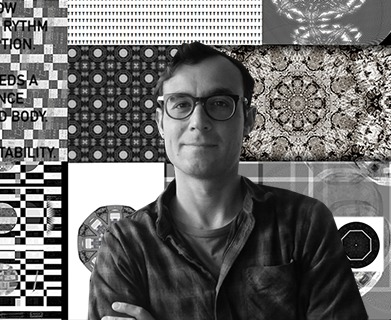
Luca M. Damiani
Luca M Damiani is a Media Artist and an Associate Lecturer Graphic & Media Design at the University of the Arts in London. Luca practices internationally in the fields of the Arts, Digital Media and Visual Culture. He works and experiments with creative techniques such as illustration, digital tech, animation, photography, coding and mix-media. His current research focus is on the role of arts&design in health, neuroscience and neuro-otology, also mainly based on an investigation of his hearing&balance disorders as well as related depression. Published artist-author of several books and academic articles, in his personal research and practice, Luca has also collaborated with many institutions and leading organisations, such as Computer Arts Society, Mozilla Foundation, VFX company Framestore, The Walt Disney Company, NGO Amnesty International, BBC, TATE, V&A, Hearing Health Foundation, British Medical Journal within Medical Humanities, etc.
Welcome, Luca!
Hi. First of all, I hope you and your friends and families are keeping well and safe during this difficult and strange time we are all living through.
I am from Cagliari, Sardinia (Italy) and my upbringing was a mix of urban and countryside flow of life, and lots of seaside. My father Gianfranco is an electronic engineer and he was away a lot for work when I was a child, and I saw him very little, but good memories; my mother Graziella is a doctor and when I was young she was busy in hospitals and clinics whilst also being a wonderful mum. Both my parents loved art and our house was just packed with frames on all walls…that was before Instagram even existed as a concept. But imagine a classical look of an Instagram page full of different images, and you will have a good idea of almost all the walls in our house in Italy!
My sister Mara (who is a brilliant graphic designer) is almost 10 years older than me and she left home for university when I was 8. So, during my upbringing, I spent lots of time with my grandmother “Maria” Margherita (well, I thought that was her name…but her name was actually only Margherita, but I have just found out: don’t ask!!) – she used to live in the flat just next to ours, and she and I had a great relationship. Lots of cooking, pasta and pizza making (she was the best at fried Neapolitan little pizzas, which of course are also in the book!), TV-drama watching (I remember she loved a US drama about fashion), cloth making, and playing cards! In the book, there are lots of these aspects too.
As a child I was a bit of a loner with my West-Highland Terrier dog Malu’(!) and I loved maths. I really enjoyed mathematical problems and functions, and all that…and I loved geometry as a way to visualise complex scientific/mathematical figures and functions. I also liked table tennis, especially playing it on the kitchen table using milk bottles and pasta packages instead of a net!
As a child my main focus was maths…and maths…and maths! But then during my teenage years I started to be a very active swimmer in a club and also started to be in love with artistic creations. My sister Mara was studying fine art at the time, and she was (is) very talented…and so I was inspired by her too. My artistic outputs at that time were mainly lines (sometimes obsessive lines) and shapes (mainly triangles) and colours: all very abstract. I mainly liked messing things, materials, words from books and philosophical concepts on the wall of my room or on canvas. But it was just a way for releasing emotions and teenage anxiety really, just trying to find myself I suppose.
After finishing high-school (which of course had a focus towards scientific subjects) I did a BSc degree in Computer Science at University in Cagliari (Italy), which in the end spanned out in 1 year and a half in Cagliari, then six months at the University in Milan (my brother-in-law died in a car accident and I moved there to live with my sister and child), then around 10 months of Erasmus project at a University in Strasbourg (France) and around 8 months of apprenticeship and practice-based thesis at a University in Barcelona (Spain). During these 3 years there were lots of ups and downs, and I was mainly working on computer projects, especially on analysis with related visual diagrams of robotics and coded communications. I remember a robot-spider walking on the ceiling of the Computer Lab I was working on in Barcelona, and it was so, so cool! But then the metal spider fell down from the ceiling and smashed on the floor…and I thought, poor her!!! 🙁
And so, yes, it is actually during this 3 years of experimentation and learning within the BSc studies that I started to follow more Digital Art and Computer Graphics; this led me into undertaking a 1 year MA in Digital Art and Digital Creative Methods at the Multimedia University of Turin (Italy). After 8 months of the MA I started to work in an animation studio in Monza, near Milan; I worked for 6 months there, whilst also going to Turin to do the MA exams. After that, I left Italy again and I moved around Europe a bit, working in various different animation and digital studios. After a couple of years, I joined Visual Effects and Film company Framestore in London and whilst working on various Hollywood-film projects, I started restudying again in a post Grad course in Fine Art Photography at Central Saint Martins (at the University of the Arts London which is where I now teach!). I really had lots of energy then and didn’t need to sleep! I just wanted to push more the theoretical and conceptual area of my work, and I started to find a strong link with psychology and therapy in my reflections as an artist. I then had a few books published around my artistic responses on emotions, design-therapy within portraiture, and social action. And then I started to actively work as an artist with illustration and photography as main tools for participatory workshops with children and families and mainly looking at aspects of identity, social engagement and social change. This was back in 2008, and this has then evolved in different ways and in different medium.
It was and is important that my practice is part of an ongoing conversation on the role of the arts in various sectors; that has been a progression of my practice working and collaborating with many institutions and leading organisations, such as Computer Arts Society, Mozilla Foundation, Framestore, The Walt Disney Company, NGO Amnesty International, BBC, TATE, V&A, Hearing Health Foundation, British Medical Journal within Medical Humanities, etc. I have been lucky to have worked, collaborated and met with amazing people in various professional fields; this has enabled shaping experiences that also inspire my own artistic development and commitment.
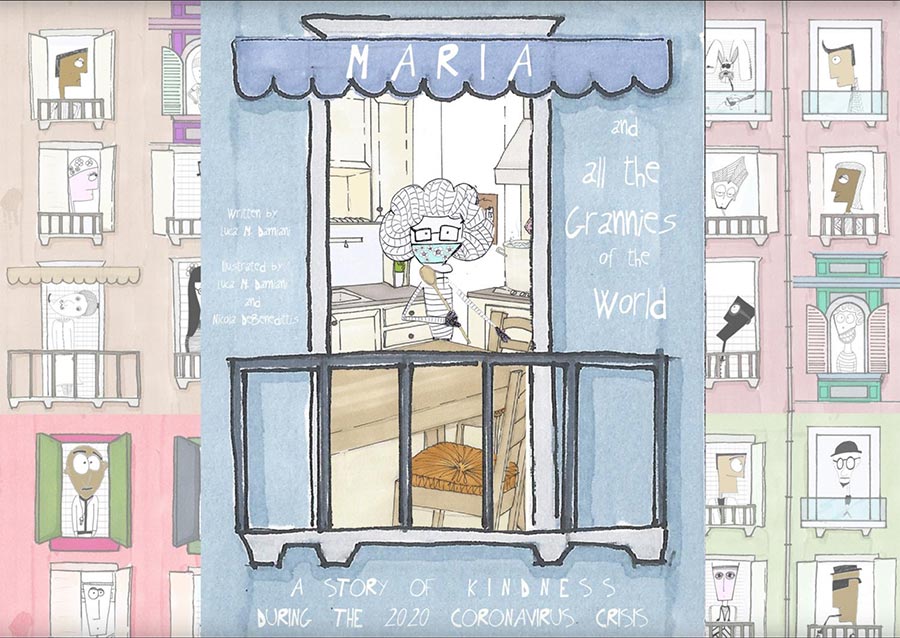
Title still from Maria, now available worldwide and open access.
Italy has been hit particularly hard by COVID-19, and while you’re based in London, your family still lives in Italy. How has everyone in your family been coping with this crisis? Living apart from your family, how has the COVID-19 pandemic been affecting you as a person and as an artist? When and why did you decide to create the audio-visual book Maria and all the Grannies (Nonnas) of the World?
I actually now live in Hastings on the South-East coast; I moved here from London around two years ago because I had a very bad acoustic accident which caused me a severe hearing disorder and sensorial disability. I suffer from Persistent Postural Perceptual Dizziness (with various attacks of vertigo) and a severe Hyperacusis (high sensitivity to sounds); this has affected massively my emotions too within my condition of high-functioning Asperger’s. So, basically, even before the lockdown my life had changed quite a lot due to the accident as I had stopped being able to even go to a cafe, or a restaurant or a public place; I cannot even listen to music properly anymore and/or have a proper dinner with friends like I used to. But hey, that’s life, and it has been two years and a half now, and I am doing lots of therapies and I am followed by a wonderful medical team. So, yeap, lots of changes in my life in the last couple of years and which is why I moved to lovely Hastings with my partner Elizabeth and my two Italian Greyhound dogs (Tootsie and Piccolo) as I could not manage to live in London anymore. But this is all another story anyway…!!!!
So, yes…my dear family is in Italy and yes, Italy has sadly been hit very hard. It was the first place in Europe that suddenly had to deal with this pandemic and it is so sad that the impact was so quick that it was also difficult to even prepare a little bit for it; it was a massive shock for Italy, and then it has been a shock for every other country after that too.
I actually created this storybook with my family and with Italy in my heart…and I have based it firstly on my late granny “Maria” Margherita and my mother Graziella (and the character in this story actually looks like my mum!). I made it first for my immediate family in Italy and for my partner’s family in the UK, as I wanted to share love with them, even if we were apart. And it was also for my wider family, my dear uncles and aunties and cousins and their families who live in the “red-zone” of North Italy (Milan, Turin, Como and Parma) where the coronavirus is widespread and who have had to stay all day, every day inside their homes for over 8 weeks already to try and help stop it spreading more. One of my aunties ended-up in hospital (now back home), so you can imagine the worries we were all living; plus, my mother is a just-retired doctor but she started helping (even if not on Covid-19 cases luckily) with some consultancies here and there, so there were lots of worries that I wanted to channel in a positive manner. And I surely felt that I did not want to channel these feelings for myself only, but I wanted to create a message of love and hope to share with my family and friends.
And so I wrote, illustrated and designed the story of Nonna Maria from Hastings. I worked together with my nephew Nicola DeBenedittis (who is 17) who has been doing some work experience during an internship with me on some of my projects since November 2019, and he wonderfully co-illustrated the book with me from Italy where he lives. Nicola and I had already started a project together late last year when he was staying with me in the UK; we wanted to create a recipe book in memory of my granny and his great-granny. After Nicola went back to our family in Italy in late January 2020, we kept working together at distance on the recipe book. But then the coronavirus Covid-19 began to spread and things changed so suddenly and quickly in Italy and all around the world; life as we knew it stopped. With my family so far away, I started reflecting on what my granny had done at another very painful and difficult time during history–the Second World War. And then I thought about what my mother (Nicola’s granny) Graziella is doing now; or what Luisa (Nicola’s other granny, who has just lost her brother due to Covid-19) is doing too, and what many other people are doing to help one another all around the world, all in their own different ways. I felt that I then wanted to create a children’s picture book to show how resilient, kind and resourceful people can be when times are hard. And so the story of Nonna Maria began–and I do hope this little book, in amongst the difficulty and sadness of this time, can give a little hope and show us how a little kindness can, in spite of great troubles, lift our spirits.
I first created the book in English, then Italian, then Spanish and French, all available online as open access. And then I decided to create a visual-audiobook, and I developed that also in collaboration with good friend and brilliant composer and musician Riz Maslen who created the all sound and music, bringing the audiobook to life in a new way; and with my partner Elizabeth Lucy Wells who works for a National Health Service in the UK, within an NHS Mental Health Trust in Sussex as the Lead for Arts & Health, who helped me in editing the video-audiobook. So the creating the audiobook was a joint effort and I could not have done it without help, and also without the love and support that both Lucy gave me in the process, as well as the emotional support from my friends Tripp Hudson, Chiara Camerada and Matteo Garau. It was not easy to create this story from both an emotional and practical-production point of view. And I did it quite quickly because I wanted to share this with my family and send them all my love in a special way; I thought it was a good and special way to show and share my love for them during this very sad time.
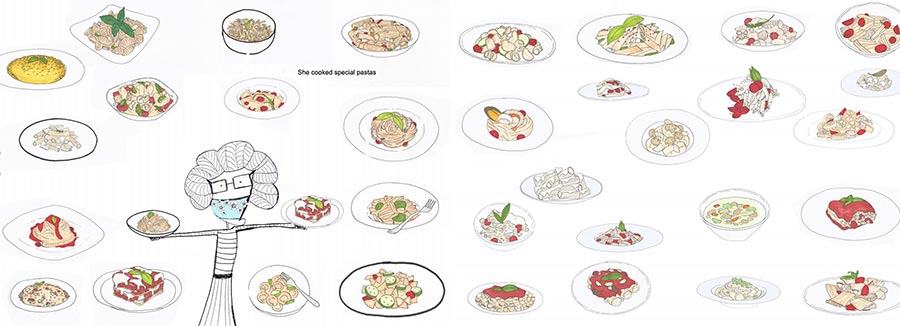
Maria and all the Grannies (Nonnas) of the World tells a lovely and uplifting story about an Italian grandma, Maria, who cooks and delivers food to other older people in her community and whose kindness has created a ripple effect in communities across the world. We know that when it comes to Italian culture, there’s something truly special about the role grandparents and their homemade food plays. In your understanding, how have grandparents and their homemade food shaped the Italian culture? What’s your favorite dish cooked by your grandmother? As Coronavirus spreads, how has the culture and society been reacting to the tragedy that Italy’s elderly has been suffering?
Grandmothers are the best!!! In Italy, Nonnas are the coolest ladies in the world! 🙂 Just joking, no national identity is important here! I think grandmothers and elders in general are amazing in every country, everywhere. And all the people I know have special connections with at least one of their grandparents in Italy, in the UK, in Spain, in France, in China, in Germany, in the US, in Canada, in South Korea, in New Zealand. Which is why the story started with my grandmother, but it then evolved with all the grandmothers of the world! And yes, there is lots of Italian culture in this little story, in terms of cooking, sharing, singing, but this book is actually representing also a community spirit that I believe is everywhere (even if maybe expressed in different ways). Everyone, everywhere, is reacting to this in a community led manner, with small gestures or with bigger social actions. We all are in this together, and this pandemic really brought us all together.
This story is also a message to all the people who lost their grandparents and elders during this difficult time. It is a love letter for all the people and elders that the Coronavirus is taking away from us – it is a tragedy for many communities who are losing a generation–parents and grandparents–and their most vulnerable dear family members. Our hearts break that within this loss, people are not able to be physically close to those who get sick and are at the hospitals; no chance for a face to face good-bye, a last hug, a last kiss.
In all this (reconnecting here to the bit of your question about my favourite dish…) I do like Pizza, just Margherita (of course because that was my grandmother’s name and it is also my middle name!) but with additional anchovies and capers on it. Then in this difficult moment, I also still love Tiramisu…which, in case you didn’t know, it spells in three words Tira-Mi-Su which means Pull-Me-Up. So, even in this moment of time, I enjoy a couple of teaspoons of tiramisu that also help to pull my spirit up.
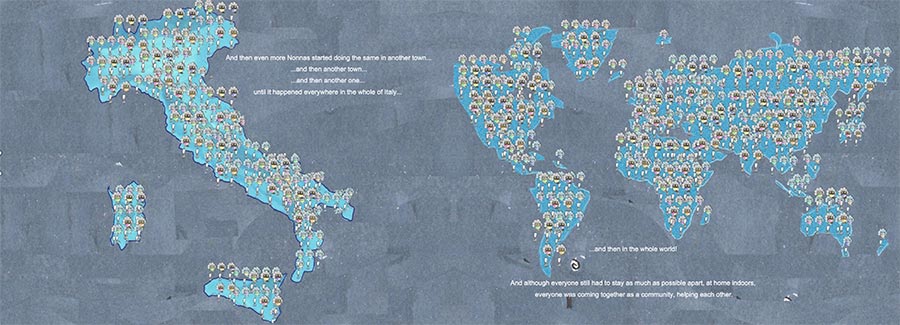
While the book is about Maria and all the grannies of the world, the story seems to be written and illustrated from a child’s perspective. To me, the contrast creates a beautiful life-cycle impression, which coincides with the reality that the elderly, just like children, are especially in need of our care and protection when facing the Coronavirus. Why did you choose to tell the story from a child’s perspective? What messages would you like to deliver to your young readers?
It’s strange that when we grow as adults, we have that feeling of trying to contextualise the meaning of “age”… somehow, we do have our lived children years in us still, as well our teenage years, etc. So we all have that lived experience of seeing things from a child’s perspective as well as other perspectives really. In addition, the character of Nonna Maria reflects my mother Graziella who is 67 now, and she is always happy, playing with her grand-children and she is super fun…I love it and I think that aspect is present in the book, especially when she dances with the frypans with the pasta in it!!
I wanted her spirit to be kept in the story; it was not easy to maintain a good deep message in such a sensitive time but also balancing it with humour. And there are also lots of memories of my childhood in this story…it is all very emotional for me.
Nonna Maria is a story for all of us…and of all of us. Young readers but not only. My granny believed in the simple good things in life, and how important it is to share the love we have, in whatever way we can and whenever is possible, even if these are little things, and this is even more important when times are hard. She certainly shared her love (and her food and cooking!) with me, and so here in this book I share that with you too, and write some of her spirit into this story. For all of us, whilst we must stay apart, where the feelings of loneliness and worry in our isolation can feel overwhelming, acts of kindness, no matter how small, matter like never before. We all are in this together, everywhere in the world; and though some are more impacted than others, this is a shared experience. And so, like I know my granny would have done, let us try and be there for each other in all the different ways we can.
In the story, Maria cooks traditional Italian meals and packs them in parcels, which are then delivered on a washing line hooked across buildings like a pulley. I have read similar news stories about Italians hanging food baskets from balconies to help the homeless and other vulnerable people. Is this where you drew your inspiration? What are your other sources of inspiration?
Yes, this story is a combination of real stories during this pandemic. Somehow it is a fictional story but with lots of real characters, and many inputs from real life. For example, first of all my grandmother and mother’s actions as I mentioned earlier. Then, yes, people in Naples leaving food in baskets hanging from their balconies so that people in need can take a box of pasta, or some vegetables to bring home for example. And then children studying at home and adults working from home, everywhere in the world really. And then the Italian singing from the balconies, which is also happening in Spain, France and other places. And then I read about one French guy who ran a marathon on his balcony, so I had to add him into the story (Merci Monsieur!) but that also represented other people around the globe who then started running marathons in their living-rooms! And then some of my neighbours and friends in the UK are in it too, and many other little inputs from here and there…and there and here. And actually, all the characters (human or not!) are a representation of someone I know; from my family but also friends. It is really an Italian and an International story in all the various details, and so we could even say that it was a way of documenting this historical time we are all living.
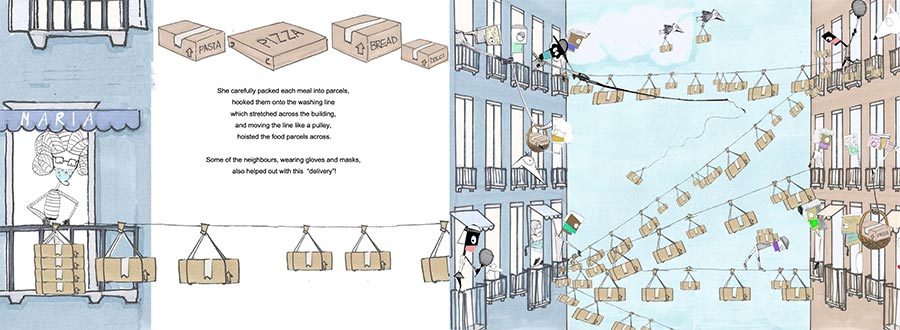
As a multimedia artist, you have practiced and integrated diverse formats. This time, you created Maria and all the Grannies (Nonnas) of the World as an audio-visual book that incorporates illustration, animation, and singing–why is that? How do different formats of media work together for you?
Crossing and bridging artistic media is part of my practice (and the practice of many others too!) and I believe it is a way to bring different voices and different emotions onto the table. Within this story it all started with the writing…then the illustrations , and then all the compositions and layout of the pages to visualise the whole narrative. I tried to give space for the reader to navigate the story but also to sometimes get lost on the details especially of the food!
And then I recorded my voice to go with it; and it just felt the right way to tell this story, and my Italian accent felt even more appropriate for telling the story!
And then I edited the video and added little tiny bits of animation and compositing that helped bring some life to the various characters…nothing too complex, but it’s tender and soft, and also fun, like the story is.
And then the singing element – I mean, that is just my THANK YOU and GOODBYE to all the elders and all the people we are losing during this pandemic. But it is also a thank you for everyone really. I do hope you can sing along too, and maybe sing it out of your window at 7:30 in the evening too…!
Implementing art integration fosters cooperation among artists and experts across different fields. Would you introduce your co-creators and editors in this project? How did the cooperation happen, and was the co-creating process this time significantly different due to the pandemic?
I mentioned Nicola, Lucy and Riz earlier, but here I share some of their thoughts in order to answer to your question directly.
Nicola says: “Working on this story-book was a great experience for me. After finishing my exams in Italy (which are the equivalent of GCSEs in the UK), I left school in November 2019. I had started A-Levels in Italy but I then realised it was not for me as I don’t feel I am very academic in my way of learning and wanted to do something more practical. I had come across a BTEC in Art & Design but unfortunately this course or anything like it doesn’t exist in Italy, so the only way was to take a gap-year and then apply to do the BTEC in the UK. So, I had some time on my hands! Luckily my uncle Luca had some work experience I could do with him on some of his projects in his art practice which involved lots of drawing – which was great! I started working on a cookbook he was making with different dishes and recipes from Luca’s nonna (my bisnonna or grand-mother), but then the crisis of this pandemic started happening and Luca decided to change the structure of the book and take it in a whole new direction. He used some of the work we had already done to feed into his new idea for the story of Nonna Maria, and then the real work began! I worked on sixty-two pages of drawings, following Luca’s detailed list of material he needed. I created herbs and pasta dishes, pizzas and bread, and some sections of buildings. It has been a journey of lots and lots of hours of drawing and drawing and drawing! Luca in the meanwhile was drawing hundreds of characters, places, spaces and all the other bits and pieces to bring the story together. He then brought all the illustrations together, creating the compositions of all the pages, which combined all our drawings together and making really cool scenes! I think there is an interesting merge of style with Luca’s black and white character illustrations and the water-coloured backgrounds. Luca’s layouts led to the final piece of work and I’m really pleased with it. All the drawings were drawn by hand on paper, then I scanned, cleaned, cut and composited them. It has been lots of work for both of us, and I have learnt a great deal. And although he was a pretty strict and demanding ‘supervisor’, working with my uncle Luca has been fantastic! I hope lots of children and families will enjoy our story.”
Riz says: “I have been working with Luca on another project around hearing health and mental health, and during that time we developed our collaborative appreciation of each other’s work. When Luca sent me the first draft of the story, I was straight away thinking up ideas for the possible sound of the world of Nonna Maria. I have always used and found sound in my work as a composer, and this story-book was the perfect vehicle to do something humble and soft, and yet powerful in its message. Covid 19 has affected the whole world and each day brings more news on the heroics of our doctors, nurses, health care staff and all those who work in our public sectors. The sad reality is that many people have lost their lives to this virus, but what keeps me buoyant is hearing the stories of our unsung heroes in our communities helping those less fortunate with daily gestures; the story of Nonna Maria is a celebration of all those beautiful moments that we are all able to create for one another.”
Elizabeth Lucy says: “It has been painful to watch how over the last couple of months this terrible pandemic has crept and then swept across so much of the globe, and an unimagined kind of unreality has become reality and as the days go by, is becoming normality. Tragedy and sorrow have unfolded for so many and we all find ourselves in various states of anxiety, fear, frustration and unknowing. We pay homage to those who are saving us, heroically on the ‘frontline’ in the hospitals and care homes, and also to those who are helping hold day-to-day life together for everyone, supermarkets, chemists, farms, factories, delivery vans and all those unseen workers, now facing an invisible danger as they go out to work. And for many as we sit and wait, it is really difficult to know what to do and it can be hard to stay positive and find purpose.
Although compared to the enormity of the impact this virus is having, artistic expression, the act of being creative and the sparking of imagination, can seem like small and flimsy things, but even if fleetingly these things do have value – it can inspire us to look outside of ourselves for a moment, remind us of what is good, can keep us holding on, believing and hoping for a brighter tomorrow–indeed, what else can we do?
This fantastical story simply told by a unique artist, is a gentle but powerful depiction of the beauty of human creativity and kindness. In its creation as well as the final story we read, it tells of how in helping each other we too are helped. Not a new or complicated message but profound all the same and one that resonates strongly just now. I hope it brings you pleasure in this moment, and gives a hope for tomorrow. I know it has for me and I am grateful to have been able to contribute to its creation.“
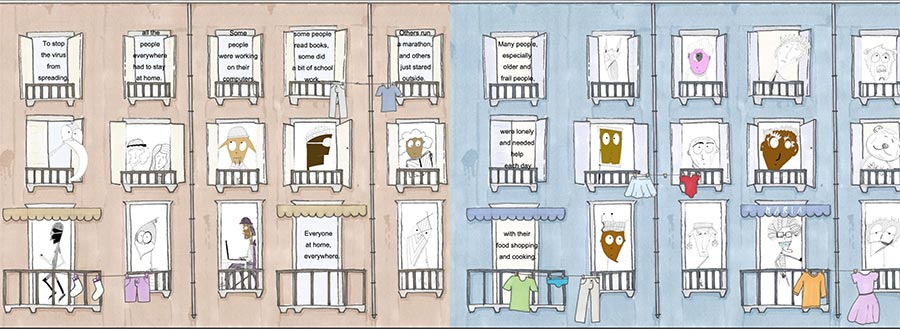
Since the publishing of Maria and all the Grannies (Nonnas) of the World online, what kind of feedback and responses have you received? As we try to stay connected to the world through screens, do you think the pandemic helps to bring the arts more into people’s lives and shed new light on access to the arts? Has your view about art, and your career as an artist, changed because of the pandemic?
The feedback has been fantastic. I have had lots of great emails and messages from parents, psychotherapists and teachers, children saying how the story has moved, encouraged and delighted. It was a lot of work to create the book in such a short time frame but to know that people are enjoying it and having their spirits lifted by it reassures us that it was definitely worthwhile!
I am very humbled by the response that I am receiving by so many people, and my heart really melts every time I get a nice email about it. Just yesterday a mother of 3 children emailed me to say that she couldn’t resist and she cried at the end of the video-audiobook, and that her children were then happily singing “Bella Nonna, Grazie Nonna” all afternoon 🙂 That makes my heart melt, I think it’s simple, beautiful and real.
Creating this piece was a good way to react to the stress of this crisis and share the message of love with my family. So, I started sharing it with my family and friends…and then more friends…and then friends shared it with their families and their friends…and with a word of mouth it was shared with the EMDR and CBT psychotherapist network in the UK as well as with various schools in Italy and in the UK; the Issuu and Yumpu links in only 8 days had over 8000 reads with 4 minutes as average time for each read, which is fantastic for a sharing of the story with just word of mouth and it also means that people are actually reading it! I have now released the visual audiobook on Vimeo, and it’s picking up too and we are at over 1000 views now. Of course this is nothing compared to the usual hundreds of thousands or few millions of readers and viewer that some authors and artists get! But hey, 10000 people around the world have read and are sharing the story; that is wonderful and also considering that all this has been done without even having a publisher, a marketing or a publicity team (apart from the team of myself and Nonna Maria in my kitchen!!) I believe it’s just beautiful: just word of mouth for sharing a story, love and kindness. I think that also reflects the Nonna Maria spirit, including the open-access identity of this story and publication too. We all are individuals who can come together as a community and share the joy between our families and friends, and that is our strength as human beings also in this difficult time we are all living. It all comes back to love.
Also, at the moment various art-platforms have started to host and share the piece (thanks!) on their platforms too, such as ArtsConnect, Art Reveal Magazine, SpreadStoriesNotTheVirus, FutureEverything, Social Distancing Festival as well as granparents’ networks such as Gransnet and NanaHood! And soon the British Medical Journal (in their Medical Humanities section) will publish it too, as well as NESTA and Trigger Publishing (which focuses on Health and Mental Health) will share it on their site and blogs/resources too. LoveReading4Kids and Winkl are also going to add it as their online resources for teachers and parents. And I am now liaising with some media platforms too, and the Italian national journal Repubblica just published it online. Having it on The Children’s Writer’s Guild site and your social media platforms is amazing, and both Nonna Maria and I feel so humbled by this! (And if you are reading this and would like to host the vimeo audiobook on your site, or blog, or wherever – please do, it is a story for and of all of us.)
I do hope that the story of Nonna Maria can also be used more as an e-learning input to create more stories about our isolations, especially with children. More narratives, more love, more hope and more kindness to share and to clearly underline how important artistic responses are for all of us during difficult times, but not only. With so much worry, hardship and for some deep sorrow everywhere, it can feel useless and even unnecessary to keep making art; but I do think it is important, maybe even more important than usual that we do so.
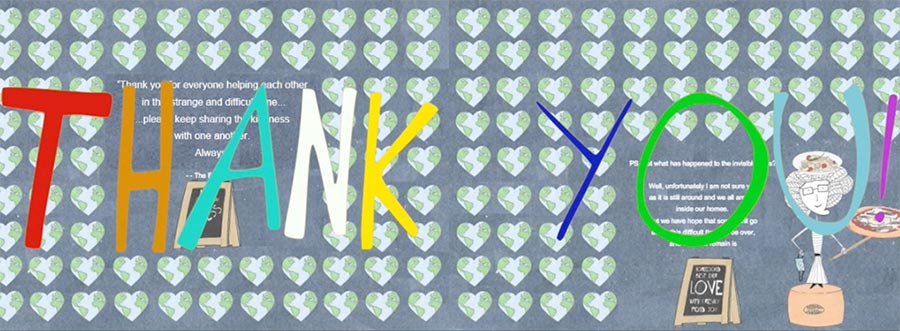
Thank you again Luca for creating and sharing Maria and all the Grannies (Nonnas) of the World and taking your time to do this interview with CWG!


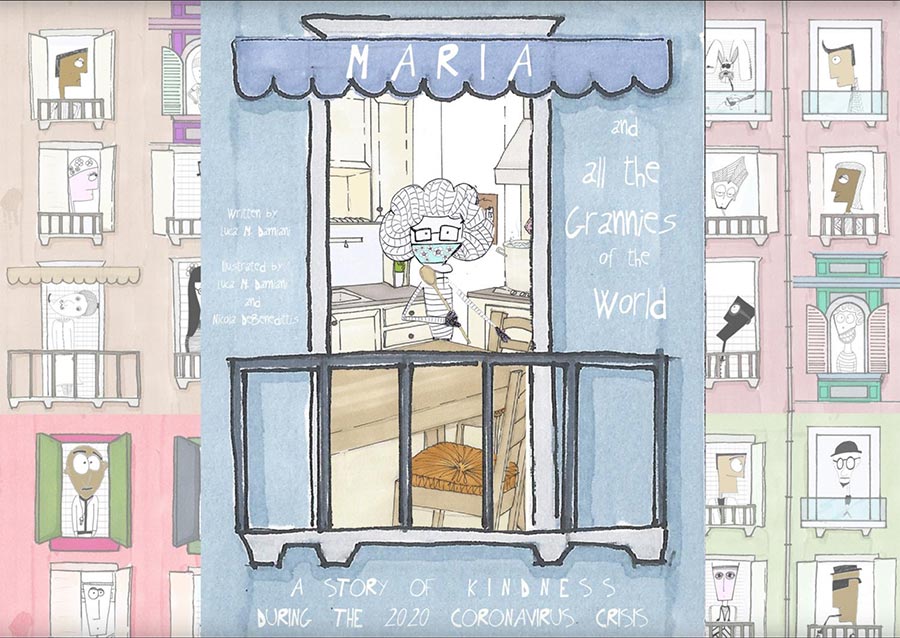
 Sihui Zhu
Sihui Zhu 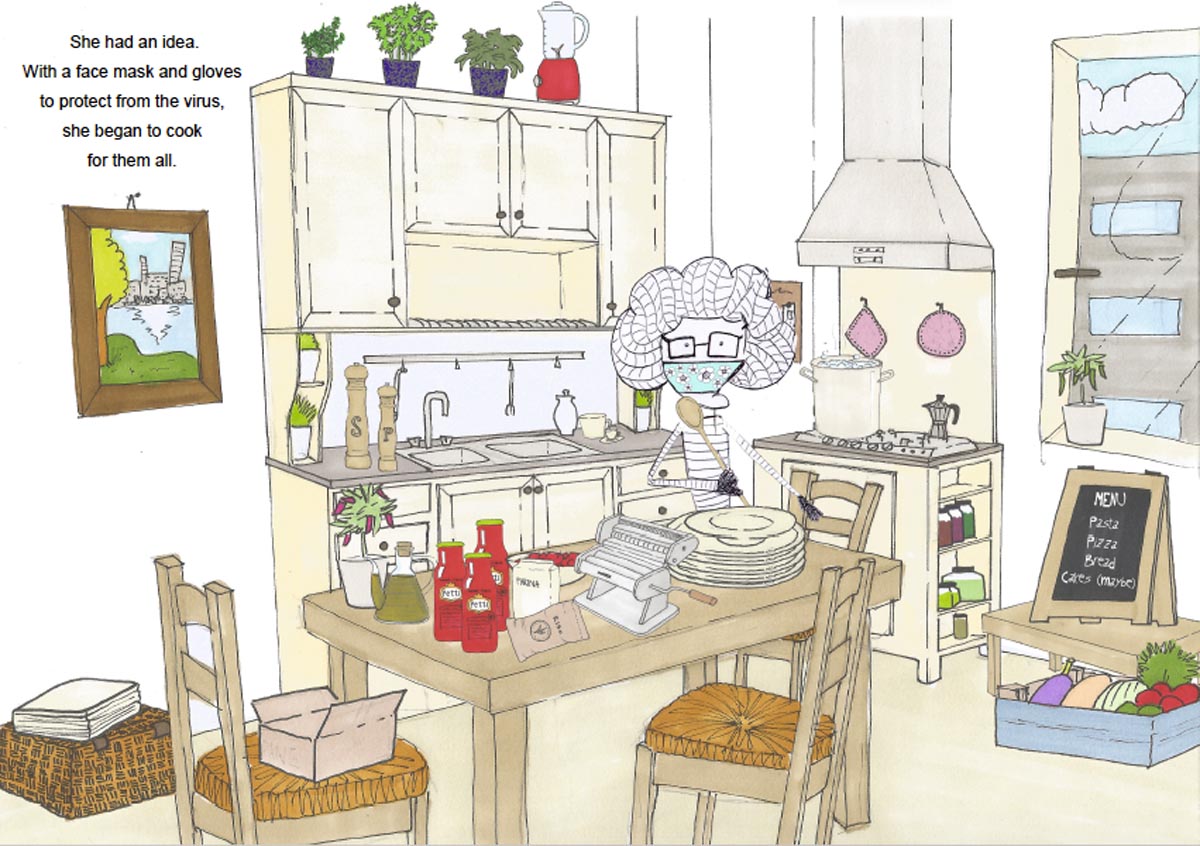
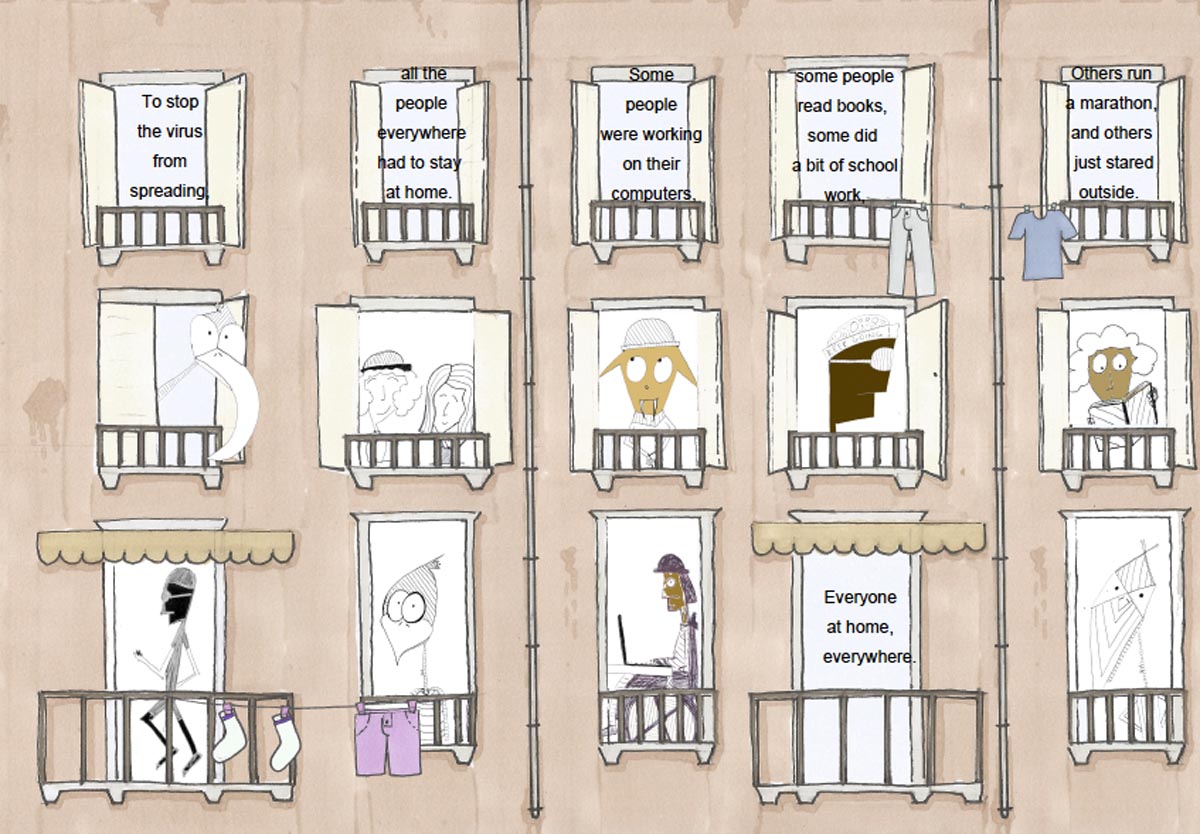
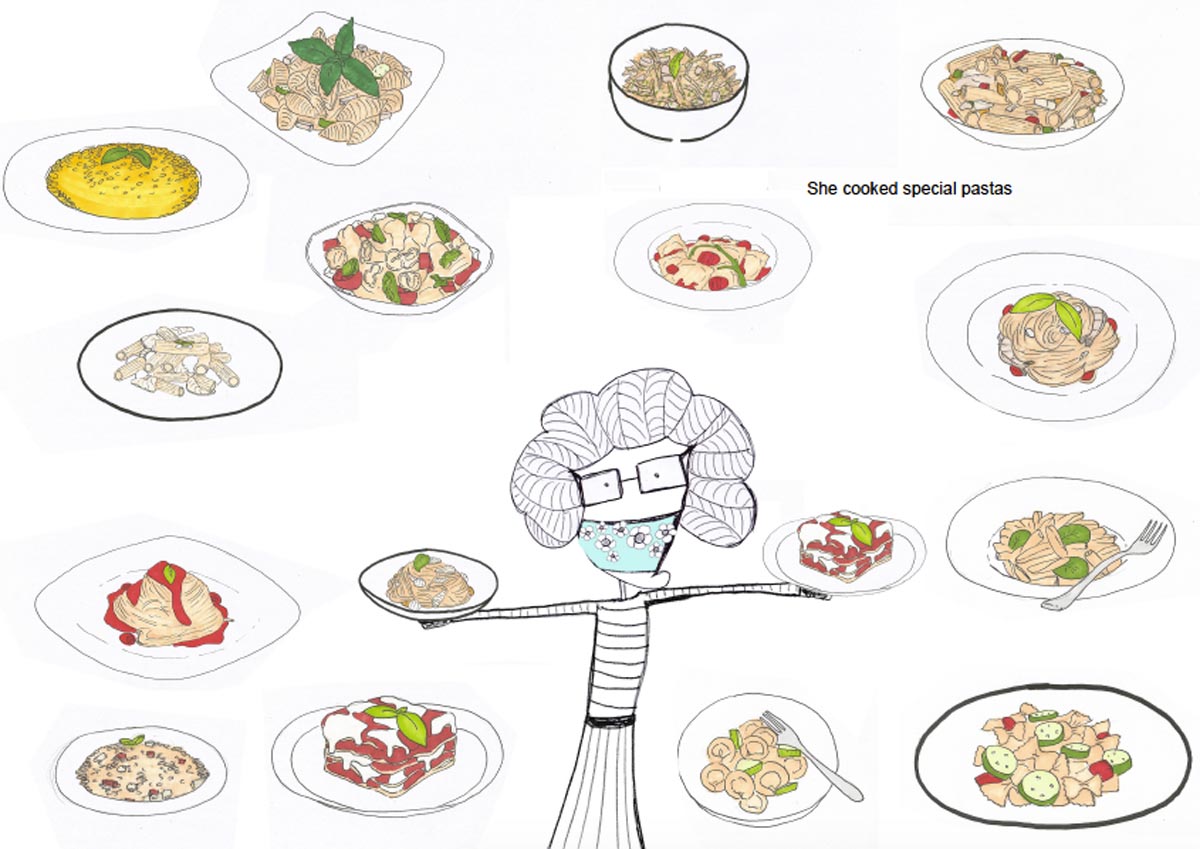
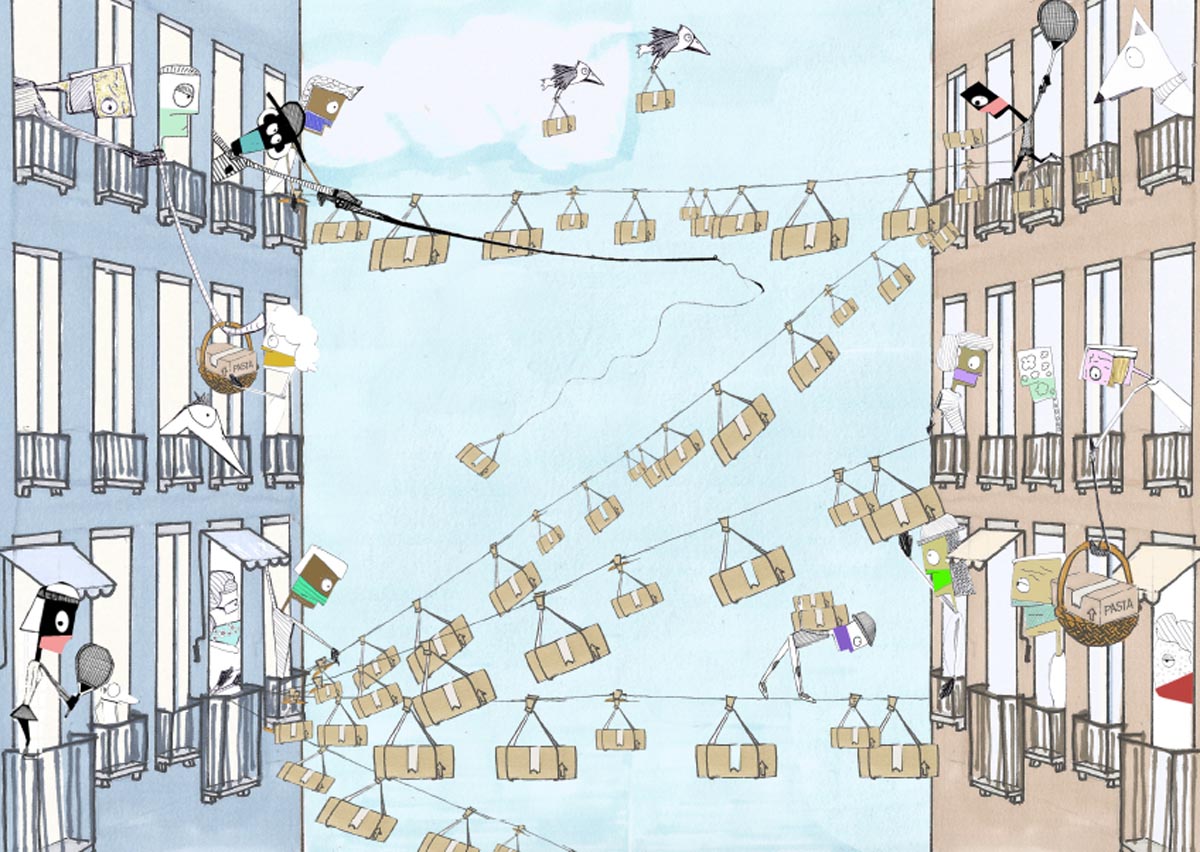
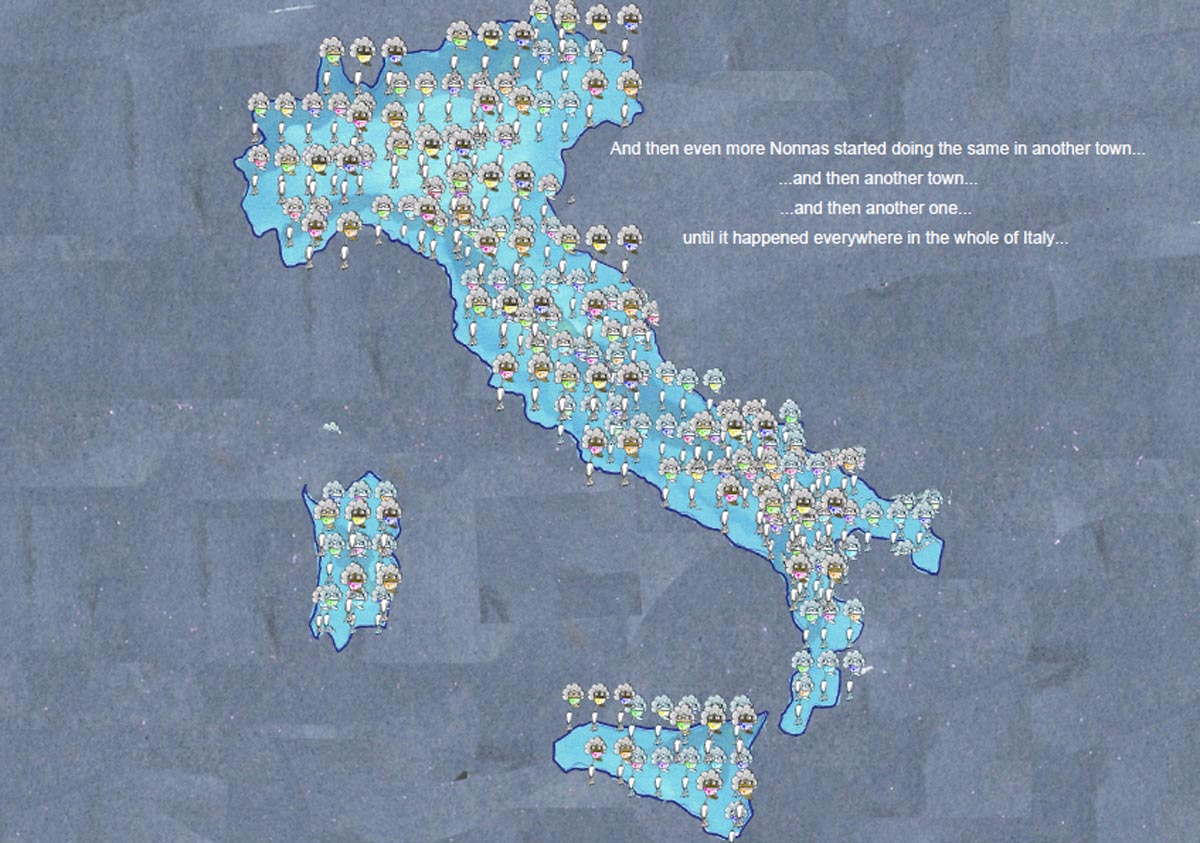
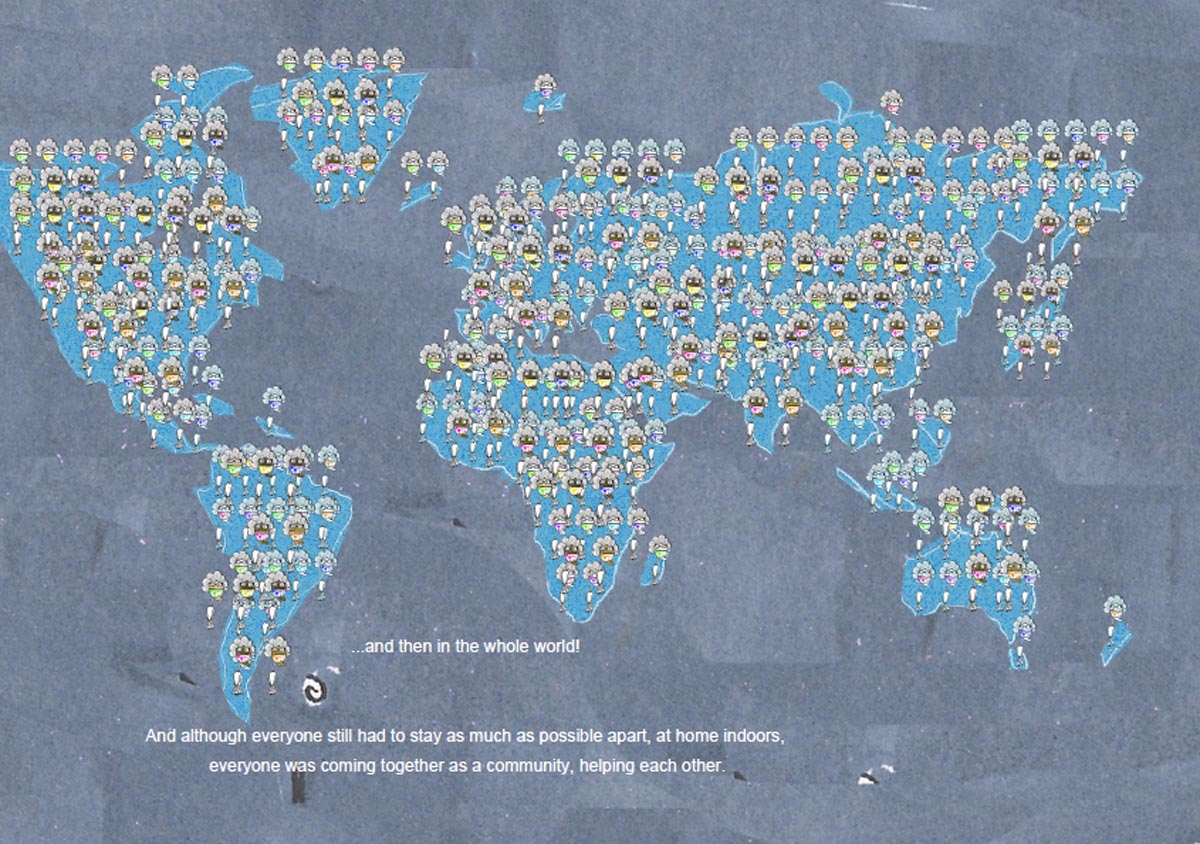
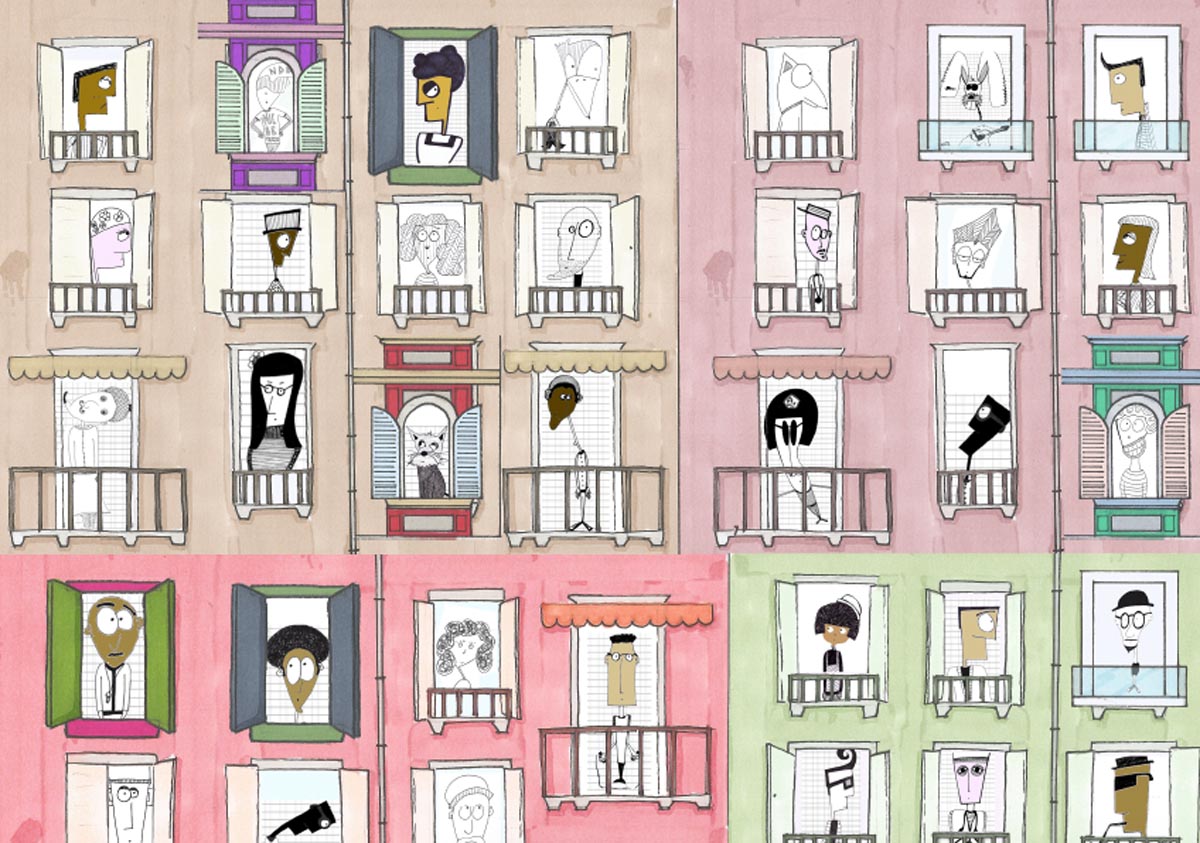
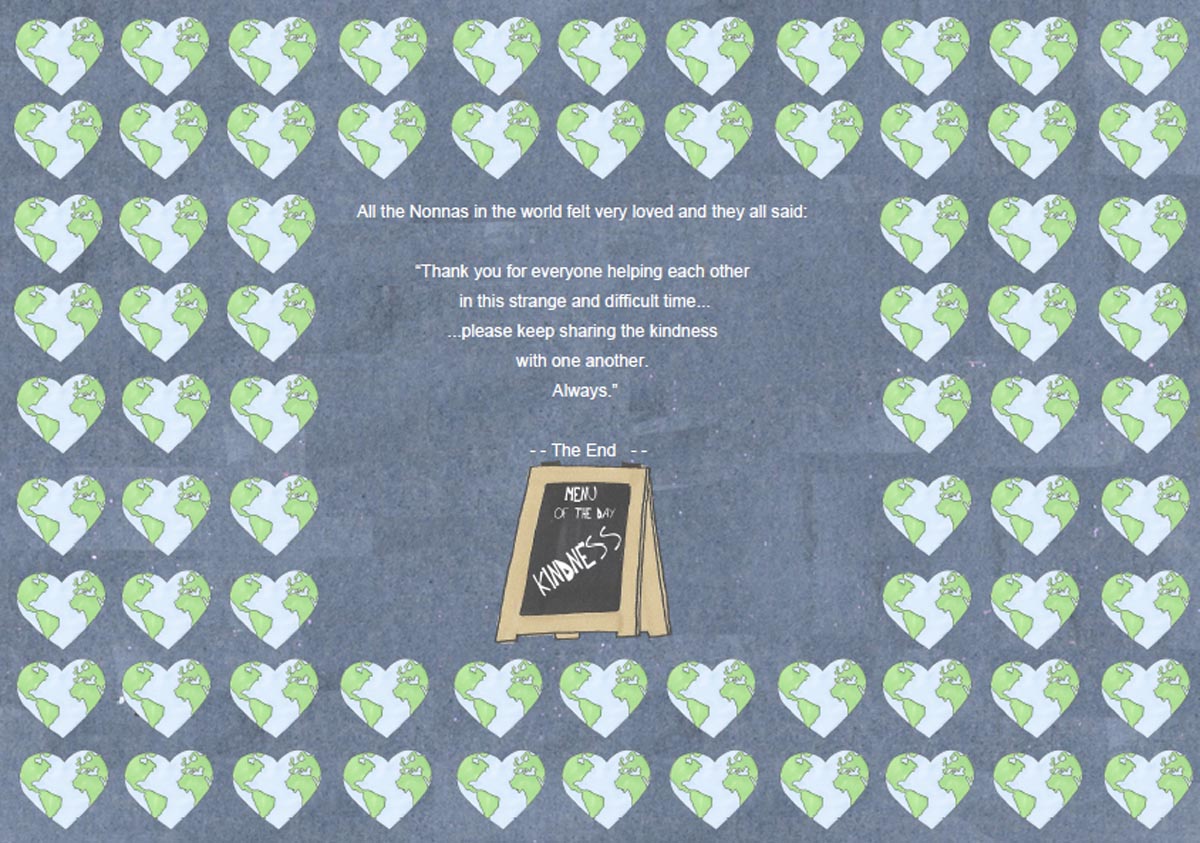

Hi, Luca! Congratulations on publishing your audio-visual book Maria and all the Grannies (Nonnas) of the World, which tells a heartwarming story about helping the elderly and supporting vulnerable communities during the COVID-19 pandemic. In a time of isolation, uncertainty and anxiety, this is an encouraging story we all need, and we are grateful that you are keeping the book open-access and are giving CWG the opportunity to learn more about you and your wonderful project.
Luca, you grew up in Italy and moved to London to pursue your career in multimedia arts which, impressively, combine photography, illustration, graphic design, film, animation and many other areas. Would you tell us a little more about yourself–your hometown, your upbringing, your family, your global living experience, and your extensive background in multimedia arts?